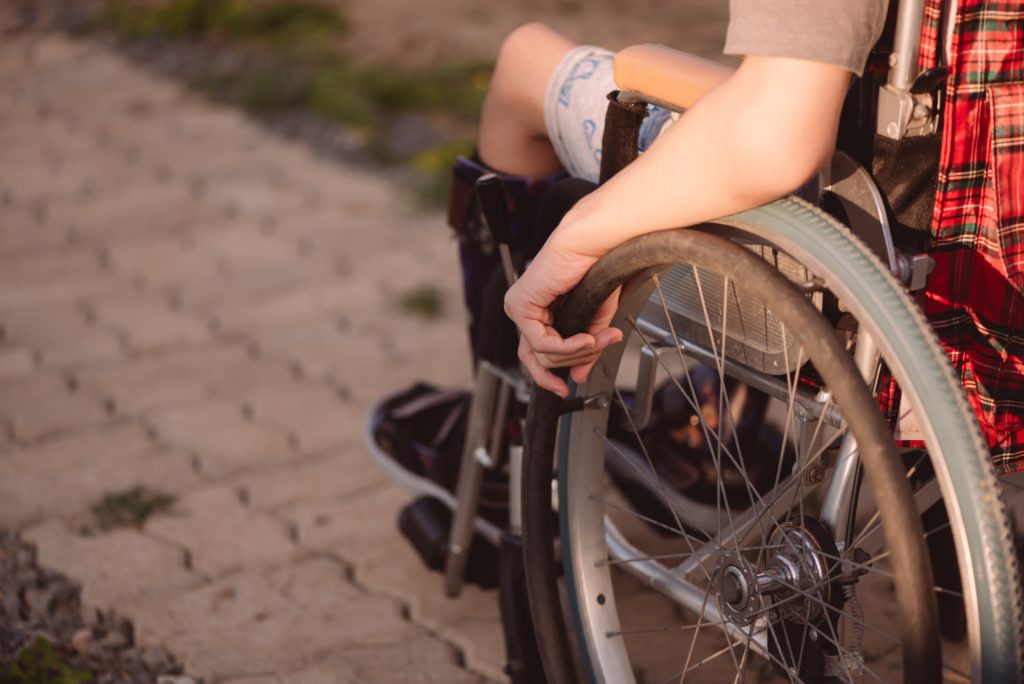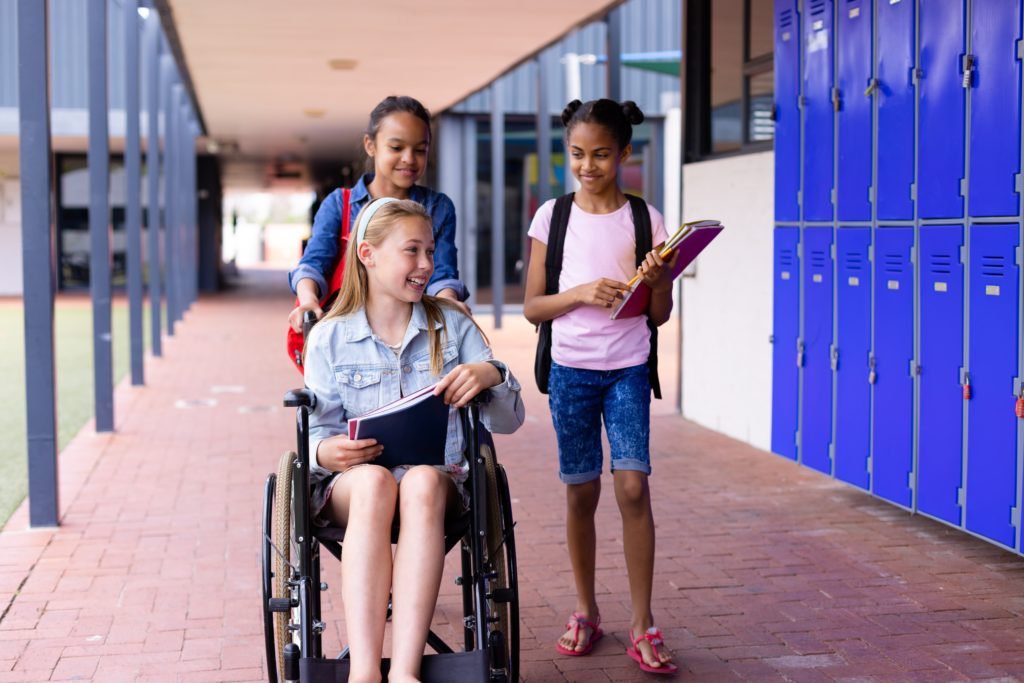Every child deserves the opportunity to learn, grow, and thrive in an environment that values and respects their individual needs and abilities. For children with disabilities, participating in mainstream schooling means more than just learning; it also represents feeling included, finding opportunities, and becoming active members of society. Although Europe has made significant attempts at implementing inclusive education for children with disabilities, challenges in achieving equity remain.
Understanding inclusive education
Inclusive education involves much more than simply integrating children with disabilities into mainstream classrooms (Graham, 2020). It also requires transforming schools—redefining cultures, policies, and practices to ensure that every child, regardless of ability, has access to the education they deserve. This approach views differences as opportunities, recognizing that each child has unique strengths and needs, which can enrich the learning experience for all students.
Research consistently shows the benefits of inclusive education, especially for children with disabilities. Inclusive education boosts their social skills, self-esteem, and academic performance while helping to combat discrimination and societal prejudice (Graham, 2020).
Europe’s legal framework and commitments
Europe’s commitment to inclusive education for children with disabilities is rooted in several international frameworks (Waisath et al., 2022). The United Nations Convention on the Rights of Persons with Disabilities (CRPD), adopted in 2006, is one of the most significant of these frameworks. Article 24 of the CRPD mandates that “States Parties shall ensure an inclusive education system at all levels and lifelong learning,” requiring countries to create inclusive education systems that support children with disabilities in the most integrated setting possible (United Nations, 2006).
The Salamanca Statement, adopted in 1994, further reinforces this principle, urging governments to adopt inclusive education as a policy. It declares that “schools should accommodate all children, regardless of their physical, intellectual, social, emotional, linguistic or other conditions” (United Nations Educational, Scientific and Cultural Organization, 1994).
Additionally, the European Union’s Disability Strategy for 2021–2030, adopted in March 2021 by the European Commission, prioritizes inclusive education by setting goals to improve the educational experiences of children with disabilities across Europe (European Commission, n.d.). The strategy emphasizes the need for enhanced accessibility, improved teaching practices, and increased support, ensuring that every child, no matter their abilities, is given the opportunity to thrive in education (Graham, 2020).
State of inclusive education in Europe
The most recent data in Europe point to a mixed state of inclusive education implementation across Europe (Eurydice, 2023a). A European Agency for Special Needs and Inclusive Education study reveals that about 65% of children with disabilities in Europe enroll in mainstream schools (Jodl & Bian, 2023). Still, these rates vary from nation to nation and from one disability to another.
Challenges in implementing inclusive education

Physical inaccessibility
Physical accessibility remains a significant challenge for many students. Older school buildings, especially in rural areas or historical parts of cities, often lack essential features such as ramps, lifts, and accessible bathrooms (Hester et al., 2020). This infrastructure gap means that many students with disabilities are still unable to fully access their schools (Kefallinou et al., 2020).
Inadequately qualified personnel, teachers, and assistants
Another area needing improvement is the shortage of qualified personnel, including teachers and assistants. Many classroom teachers have expressed concerns about their ability to effectively address the needs of students with disabilities in their classes (Hester et al., 2020). Better integration of culturally responsive practices in teacher training and professional development is also necessary, as this aspect remains limited and requires further attention (Kefallinou et al., 2020).
Insufficient funding and resource allocation
More funding and resource allocation are still vital to the full implementation of inclusive education for children with disabilities, as many school systems struggle to provide accommodation, modified instructional resources, and support services (Kefallinou et al., 2020). Economic disparities indicate that poorer regions and countries face even greater hurdles in accessing these resources, which are key to achieving inclusive educational practices across Europe.
Social and attitudinal barriers
Social and attitudinal barriers continue to stand in the way of inclusive education across Europe. Stigma against students with disabilities persists in many countries, often starting with teachers, peers, and even parents (Leahy & Ferri, 2023). These negative attitudes can result in bullying and prevent meaningful social integration for these students.
Obstacles to adapting curricula
Across Europe, rigid and standardized curricula often fail to meet the needs of students with disabilities. Specifically, schools require more preparation and support to modify strategies and tools for integrating and evaluating students with varying abilities (Schwab, 2020).
These issues are even more apparent in those countries where an inclusive education system is not well-funded or where little emphasis is placed on adopting such strategies in pre-service teacher training programs (Schwab, 2020). To tackle this concern, European countries have to invest in developing more flexible curricula and provide teachers with the training and resources they need to create inclusive classrooms for all students.
Country-specific implementations
Progress and persistent gaps in France
France has made strides in creating a more inclusive education system, with more than 80% of students with disabilities attending mainstream schools (Graham, 2020). This shift has been supported by the introduction of school support assistants, known as Accompagnants des Élèves en Situation de Handicap or AESH (Ministère de l’Éducation nationale, 2015, 2024). These assistants are essential to help students with disabilities participate in school life and feel part of their community (Waisath et al., 2022).
Another important feature of the French education system is the ULIS units (Unités Localisées pour l’Inclusion Scolaire). These specialized units within mainstream schools provide extra support for children with more significant needs (Ministère de l’Éducation nationale, 2015, 2024).
Even so, difficulties persist, particularly regarding resource allocation and the availability of specialized staff to support students with disabilities in mainstream classrooms (Shaw, 2021). Additionally, many students with disabilities receive limited hours at school—sometimes as few as six hours per week—due to a shortage of support staff (European Agency for Special Needs and Inclusive Education, 2020). At the moment, France’s “school for all” policy ensures that over 80% of students with disabilities attend mainstream schools, supported by inclusive model schools that foster equitable learning environments (Graham, 2020).
Italy’s inclusive education model and its evolution
Italy has been a global leader in inclusive education since 1977, successfully integrating nearly all students with disabilities into mainstream classrooms (Schreuer et al., 2024). This achievement is largely due to the use of “support teachers” or insegnanti di sostegno, who work alongside regular teachers to tailor lessons to meet the diverse needs of students, ensuring that no child is left behind (Graham, 2020; Schreuer et al., 2024). This inclusive approach fosters a supportive educational culture and helps reduce the stigma associated with disabilities (Doyle & Giangreco, 2015).
Despite this progress, the influence of the traditional medical model of disability persists in educational practices, and efforts to fully embrace a social model that prioritizes rights, accessibility, and support for all students are still evolving (European Agency for Special Needs and Inclusive Education, 2021; Ianes et al., 2020).
As of recent reports, Italy has achieved a 99.6% integration of children with disabilities into mainstream schools, using a support teacher system that enhances inclusivity without creating distinctions among students (European Agency for Special Needs and Inclusive Education, 2016, 2021; Ianes et al., 2020).
Canton-specific efforts in Switzerland
Switzerland’s approach to inclusive education varies across cantons, as each canton is responsible for its education policy (Shaw, 2021). Since 2008, cantons have been in charge of special needs education, covering technical, legal, and financial aspects (Eurydice, 2023b). Support measures include early childhood intervention, and the trend toward integrating children with special educational needs into mainstream schools is growing.
However, despite the development, special schools and classes for children with disabilities or learning and behavioral difficulties still exist (European Agency for Special Needs and Inclusive Education, 2018). Currently, Switzerland’s decentralized education system allows for varied inclusive practices across cantons, with progressive regions such as Ticino leading in integrating students with disabilities into mainstream classrooms and emphasizing teacher training in inclusive methods (Kottelat, 2024).
The UK’s struggle amid funding constraints
In the UK, inclusive education is legally mandated, although its implementation has faced obstacles. The SEND (Special Educational Needs and Disabilities) Code of Practice provides a framework for supporting children with disabilities in mainstream schools (Department for Education & Department of Health and Social Care, 2014).
A major issue in the UK is the unequal distribution of resources and support, with many schools dealing with budget constraints that hinder their capacity to accommodate students with disabilities (Francisco et al., 2020). This issue has caused funding disparities across local authorities, which impact the quality of support and the availability of resources across regions (Jeffreys & Rhodes, 2024; Local Government Association, n.d.; Nye, 2024).
For the time being, the UK’s Education, Health, and Care (EHC) plans provide a comprehensive framework that unites education, health, and social care services to meet the individual needs of students with disabilities (Department for Education & Department of Health and Social Care, 2014; Mitchell & Sutherland, 2020).
Recommendations
Strengthening policy frameworks and financial support
Governments must strengthen the legal frameworks surrounding inclusive education and provide sufficient funding to ensure that all schools can meet the needs of children with disabilities. Teacher training must be expanded to make sure that educators are equipped with the knowledge and skills to support students with disabilities effectively (Schwab, 2020). Schools should be made physically accessible, and assistive technologies and other support services should be widely available.
Cultivating inclusive school cultures
There needs to be more emphasis on changing social attitudes toward disability. Schools play a key role in this regard by providing education, fostering open-mindedness, and creating an environment where every student, regardless of their background, is respected.
Education and awareness programs for teachers, students, and the wider community are also crucial for reducing stigma and promoting inclusion (Mitchell & Sutherland, 2020). Additionally, initiatives such as peer mentoring and social interactions between disabled and non-disabled students can help break down stereotypes and encourage more positive attitudes (Schwab, 2020).
Fostering cross-country collaborations and knowledge sharing
Cross-country collaborations and knowledge sharing can help European countries learn from each other’s successes and challenges, ensuring that the best practices in inclusive education are widely adopted across the continent (Leahy & Ferri, 2023). By creating strong networks of schools, teachers, and education professionals, countries can facilitate the spread of effective strategies faster and more widely.

Humanium is dedicated to ensuring that the rights of every child are respected. We raise awareness about the importance of providing access to quality education for all children, including those with disabilities. Join us in making a difference—support our mission by donating, volunteering, or becoming a member.
Written by Or Salama
References:
Department for Education & Department of Health and Social Care. (2014, June 11). Special educational needs and disability code of practice: 0 to 25 years. Retrieved from GOV.UK at https://www.gov.uk/government/publications/send-code-of-practice-0-to-25, accessed on November 8, 2024.
Doyle, M. B., & Giangreco, M. F. (2015, November 1). Italy presses forward in educating students with learning disabilities. Retrieved from Phi Delta Kappan at https://kappanonline.org/italy-educating-students-learning-disabilities-giangreco-doyle/, accessed on November 8, 2024.
European Agency for Special Needs and Inclusive Education. (2016, September). Country policy review and analysis: Italy. Retrieved from the European Agency for Special Needs and Inclusive Education at https://www.european-agency.org/sites/default/files/agency-projects/CPRA/Phase1/CPRA%20Italy.pdf, accessed on November 19, 2024.
European Agency for Special Needs and Inclusive Education. (2018, March 12). Country information for Switzerland – Systems of support and specialist provision. Retrieved from the European Agency for Special Needs and Inclusive Education at https://www.european-agency.org/country-information/switzerland/systems-of-support-and-specialist-provision, accessed on November 9, 2024.
European Agency for Special Needs and Inclusive Education. (2020, April 28). Country information for France – Legislation and policy. Retrieved from the European Agency for Special Needs and Inclusive Education at https://www.european-agency.org/country-information/france/legislation-and-policy, accessed on November 8, 2024.
European Agency for Special Needs and Inclusive Education. (2021, May 4). Country information for Italy – Legislation and policy. Retrieved from the European Agency for Special Needs and Inclusive Education at https://www.european-agency.org/country-information/italy/legislation-and-policy, accessed on November 9, 2024.
European Commission. (n.d.). Union of equality: Strategy for the rights of persons with disabilities 2021-2030. Retrieved from the European Commission at https://ec.europa.eu/social/main.jsp?catId=1484&langId=en, accessed on November 18, 2024.
Eurydice. (2023a, October 10). Promoting diversity and inclusion in schools in Europe. Retrieved from the European Commission at https://eurydice.eacea.ec.europa.eu/publications/promoting-diversity-and-inclusion-schools-europe, accessed on December 8, 2024.
Eurydice. (2023b, November 27). Educational support and guidance. Retrieved from the European Commission at https://eurydice.eacea.ec.europa.eu/national-education-systems/france/educational-support-and-guidance, accessed on November 10, 2024.
Francisco, M. P. B., Hartman, M., & Wang, Y. (2020, September 7). Inclusion and special education. Retrieved from MDPI at https://www.mdpi.com/2227-7102/10/9/238, accessed on November 21, 2024.
Graham, L. J. (2020, July). Inclusive education in the 21st century. Retrieved from ResearchGate at https://www.researchgate.net/publication/342962600_Inclusive_education_in_the_21st_century, accessed on November 21, 2024.
Hester, O. R., Bridges, S. A., & Rollins, L. H. (2020, May 25). ‘Overworked and underappreciated’: special education teachers describe stress and attrition. Retrieved from Taylor & Francis at https://www.tandfonline.com/doi/abs/10.1080/13664530.2020.1767189?casa_token=_OsDHamM0eMAAAAA:IESoZ9Aai9h-lGJqjE7ahHFo-jJ5Ow9h6FKbEsbPCrWXZaeapNnN4syTkBPj_5o1urvK67RujXXQ, accessed on November 21, 2024.
Ianes, D., Demo, H., & Dell’Anna, S. (2020, October 8). Inclusive education in Italy: Historical steps, positive developments, and challenges. Retrieved from Springer at https://link.springer.com/article/10.1007/s11125-020-09509-7, accessed on November 21, 2024.
Jeffreys, B., & Rhodes, H. (2024, June 18). Fears for children as special educational needs budgets tighten. Retrieved from BBC News at https://www.bbc.co.uk/news/articles/ceqq46x068xo, accessed on November 9, 2024.
Jodl, J., & Bian, M. (2023, January). Global state of inclusion in education: A review of the literature. Retrieved from Inclusive Education Initiative at https://www.inclusive-education-initiative.org/sites/iei/files/2023-01/108_Global%20State%20of%20Inclusion_Policy%20Brief_V21.pdf, accessed on December 8, 2024.
Kefallinou, A., Symeonidou, S., & Meijer, C. J. W. (2020, September 7). Understanding the value of inclusive education and its implementation: A review of the literature. Retrieved from Springer at https://link.springer.com/article/10.1007/s11125-020-09500-2, accessed on November 9, 2024.
Kottelat, D. (2024, June 28). Inclusive schools: beneficial for all? Retrieved from SWI swissinfo.ch at https://www.swissinfo.ch/eng/education/inclusive-schools-beneficial-for-all/81877884, accessed on November 8, 2024.
Leahy, A., & Ferri, D. (2023, June 16). Barriers to cultural participation by people with disabilities in Europe: a study across 28 countries. Retrieved from Taylor & Francis at https://www.tandfonline.com/doi/abs/10.1080/09687599.2023.2222898, accessed on November 9, 2024.
Local Government Association. (n.d.). Bright Futures: SEND funding. Retrieved from Local Government Association at https://www.local.gov.uk/about/campaigns/bright-futures/bright-futures-childrens-services/bright-futures-send-funding, accessed on November 9, 2024.
Ministère de l’Éducation nationale. (2015, August 21). Scolarisation des élèves en situation de handicap : Unités localisées pour l’inclusion scolaire (Ulis), dispositifs pour la scolarisation des élèves en situation de handicap dans le premier et le second degrés. Retrieved from Ministère de l’Éducation nationale at https://www.education.gouv.fr/bo/15/Hebdo31/MENE1504950C.htm, accessed on November 7, 2024.
Ministère de l’Éducation nationale. (2024, August). Les accompagnants des élèves en situation de handicap (AESH). Retrieved from Ministère de l’Éducation nationale at https://www.education.gouv.fr/les-accompagnants-des-eleves-en-situation-de-handicap-aesh-12188, accessed on November 7, 2024.
Mitchell, D., & Sutherland, D. (2020, March 9). What really works in special and inclusive education: Using evidence-based teaching strategies. Retrieved from Taylor & Francis at https://www.taylorfrancis.com/books/mono/10.4324/9780429401923/really-works-special-inclusive-education-david-mitchell-dean-sutherland, accessed on November 9, 2024.
Nye, P. (2024, January 26). SEND spending needs reform to stop local authorities going bust. Retrieved from the Institute for Government at https://www.instituteforgovernment.org.uk/comment/send-spending-reform-local-authorities, accessed on November 9, 2024.
Schreuer, N., Shpigelman, C. N., Mor, S., Sarid, M., Kanter, A. S., & Sachs, D. (2024, January 3). Academic staff members’ engagement in accessible higher education for students with disabilities. Retrieved from Taylor & Francis at https://www.tandfonline.com/doi/abs/10.1080/07294360.2023.2292652?casa_token=Qr_kCViL07YAAAAA:jD74jpkRP4qJcUH1tDn2-IGn2bkxB7x8zwHD_1JSY2b4_zGpq8y_VMuTHEgfou4C_G0Bj-P4uO50, accessed on November 21, 2024.
Schwab, S. (2020, January 30). Inclusive and special education in Europe. Retrieved from Oxford Research Encyclopedia of Education at https://oxfordre.com/education/display/10.1093/acrefore/9780190264093.001.0001/acrefore-9780190264093-e-1230, accessed on November 21, 2024.
Shaw, A. (2021, August 25). Inclusion of disabled Higher Education students: why are we not there yet? Retrieved from Taylor & Francis at https://www.tandfonline.com/doi/abs/10.1080/13603116.2021.1968514, accessed on November 21, 2024.
United Nations. (2006, December 12). Convention on the Rights of Persons with Disabilities. Retrieved from the Office of the United Nations High Commissioner for Human Rights at https://www.ohchr.org/en/instruments-mechanisms/instruments/convention-rights-persons-disabilities, accessed on November 17, 2024.
United Nations Educational, Scientific and Cultural Organization (UNESCO). (1994). The Salamanca Statement and Framework for Action on Special Needs Education. Retrieved from UNESDOC at https://unesdoc.unesco.org/ark:/48223/pf0000098427, accessed on November 18, 2024.
Waisath, W., McCormack, M., Stek, P., & Heymann, J. (2022, April 4). Dismantling barriers and advancing disability-inclusive education: an examination of national laws and policies across 193 countries. Retrieved from Taylor & Francis at https://www.tandfonline.com/doi/abs/10.1080/13603116.2022.2058623, accessed on November 21, 2024.


